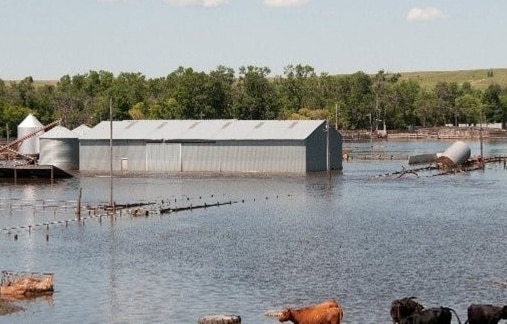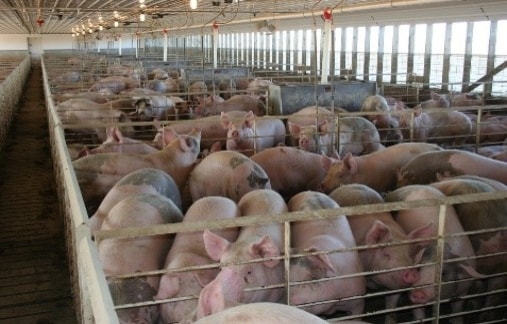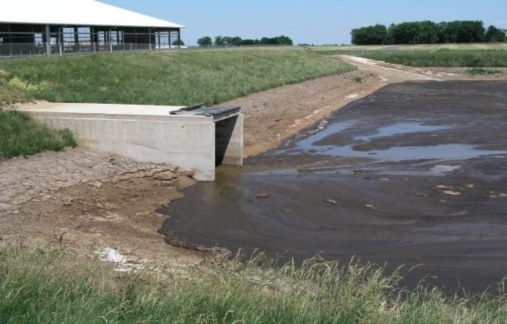Interim Guidance for Protecting Workers from Livestock and Poultry Wastewater and Sludge During and After Floods

PURPOSE OF THIS GUIDANCE: To protect workers from illnesses and injuries associated with livestock and poultry wastewater and sludge from animal feeding operations during and after floods.
Click here for a printable version of this Interim Guidance Document [PDF – 402 KB]



Farms, animal production sites, and processing plants contain animal waste. Waste or manure can be located in places such as animal housing, open lots, pastures, manure treated fields, sediment basins, above ground storage structures, underground storage tanks, lagoons, storage ponds, and manure drying or composting sites. Workers may be at risk of exposure to animal diseases that may be passed from animals through contact with workers’ broken skin, eyes, nose, mouth, or mucous membranes. Diseases may spread from contact with animals’ infected body fluids or tissues and from contaminated water or materials. Manure and wastewater may also contain additional hazardous compounds such as chemicals, hormones, antibiotics, metals, and allergens. In addition workers may encounter musculoskeletal hazards (e.g., lifting heavy animals and objects), physical hazards (e.g., unsafe buildings and structures, sharp objects, heat, noise), chemical hazards (e.g., fuels, fertilizers, pesticides, cleaning agents, hydrogen sulfide) and allergens (e.g., latex and animal saliva, skin, urine).
Examples of diseases that may be spread to workers from contact with swine and poultry and their manure include:
- Swine: brucellosis, erysipelas, leptospirosis, streptococcosis, salmonellosis, campylobacteriosis, cryptosporidiosis, giardiasis, yersiniosis, hepatitis E, listeriosis, pathogenic E. coli, ringworm
- Poultry: erysipelas, salmonellosis, campylobacteriosis, cryptosporidiosis, listeriosis, pathogenic E. coli
- Workers should watch for signs and symptoms including diarrhea, vomiting, fever, cough, fever with cough or sore throat, rash, dermatitis, wound infections, conjunctivitis (i.e. pink eye), neurological signs, or other indications of infection.
- Workers with signs or symptoms should report them to their supervisor and seek medical evaluation right away. Inform your healthcare provider about your workplace exposures.
Ensure that all employees are up-to-date on tetanus-diphtheria immunizations since employees are at risk of soil-contaminated injuries. Current CDC recommendations do not support hepatitis A vaccination for sewage workers or disaster responders. For more information, go to National Disasters and Severe Weather: Immunization at https://www.cdc.gov/disasters/disease/responderimmun.html.
The following are general recommendations for working in flooded areas:
- Wear a Coast Guard-approved personal flotation device (PFD) when working in and near water.
- Avoid driving through flooded areas and standing water.
- Avoid downed or exposed power lines (above and below ground). Electrical equipment should only be handled by trained professionals and only in a dry area.
- Avoid walking through flood debris to avoid hazards (e.g., sharp objects). Underwater fences (e.g., barbed wire and woven wire) can snag limbs and lead to severe injury or drowning.
- Avoid contact with wild animals.
- Protect yourself against exposure to mosquitos.
- Monitor your physical condition for signs and symptoms of heat-related “illnesses”.
Take the following steps when working with livestock and poultry, contaminated materials, wastewater, sludge, and floodwater:
- Avoid touching your face, mouth, eyes, nose, or open sores and cuts.
- Eat in designated areas away from animals, wastewater, and floodwater.
- Do not smoke or chew tobacco or gum.
- Cover open sores, cuts, and wounds with clean, dry, waterproof bandages.
- Wash skin with soap and water frequently, and immediately after contact with animals, contaminated materials, wastewater, or floodwater. Wash your hands after removing gloves and before eating, drinking, smoking, taking a break, or leaving work.
- If safe tap water is not available, wash with soap and water that has been boiled or disinfected.
- If soap and water are not available, use an alcohol-based hand sanitizer that contains at least 60% alcohol. Because hand sanitizers do not eliminate chemicals or all types of germs, it is important to wash your hands as soon as soap and water are available.
- Remove soiled work clothing and do not take home to launder. Launder at work or use a laundry service. For more information, go to “Personal Hygiene and Handwashing After a Disaster or Emergency”.
The following PPE is recommended for workers exposed to untreated livestock and poultry wastewater and sludge from waste lagoons:
- For all PPE, workers must be trained on what PPE is needed; when PPE is needed; the limitations of the PPE; how to put it on, use it, and take it off correctly; and how to maintain and dispose of the PPE. See OSHA’s PPE standards (29 CFR 1910 Subpart I) at osha.gov/laws-regs/regulations/standardnumber/1910/1910.132.
- PPE can increase your risk for heat-related illnesses. Gradually increase time working in heat, stay well hydrated, watch for signs of heat-related illness, work with a buddy, and take frequent rest and hydration breaks.
- Goggles or face shield: to protect eyes from splashes of wastewater.
- Face mask (e.g., surgical mask): to protect nose and mouth from splashes of animal waste or untreated sewage.
- Respirator: to protect from inhalation hazards. If undertaking cleaning processes that generate aerosols, a NIOSH-approved N-95 respirator should be used. N-95 respirators do not provide protection for chemical exposures that might be present. Wet environments may also reduce the effectiveness of N-95 respirators. R- or P-95 respirators may also be considered depending on the hazard.
- If using a respirator, the worker should be part of a respiratory protection program that includes medical clearance and fit-testing under OSHA’s Respiratory Protection standard (29 CFR 1910.134) at osha.gov/laws-regs/regulations/standardnumber/1910/1910.134.
- Impermeable or fluid-resistant coveralls: to keep untreated waste off clothing.
- Waterproof gloves (such as heavy-duty rubber outer gloves with nitrile inner gloves): to prevent exposure of hands to waste.
- Rubber boots or disposable shoe covers: to prevent exposure of feet to waste. Insulated rubber boots are also needed when working with electrical hazards.
- Duct tape can be used to seal the tops of gloves and boots to prevent water seepage.
- Workers should wash hands with soap and water immediately after removing PPE.
- PPE should be discarded in leak-proof infectious waste containers.
For more information, go to “Hazard Based Guidelines: Protective Equipment for Workers in Hurricane Flood Response(https://www.cdc.gov/niosh/topics/emres/pre-workers.html)”.
Only workers who have received proper training in animal restraint, handling, and care should work directly with displaced animals.
The following are recommendations for handling displaced animals:
- Use appropriate restraint techniques and equipment and
follow established procedures. - Wear appropriate PPE for the activity performed.
- Practice good sanitation and hygiene.
- If you acquire an injury of any kind, including bites or scratches (may transmit rabies and other infections), clean and dress the injury and report it to a health professional and your supervisor. Certain animal-acquired injuries carry increased risks of infection.
For more information, go to “Interim Guidance on Health and Safety Hazards When Working with Displaced Domestic Animals(https://www.cdc.gov/niosh/topics/emres/animals.html)”.
Before responding to an animal facility after a flood, check with state and local authorities for current guidance and requirements.
Take the following steps before entering any flooded building:
- Check for structural damage to the building.
- Shut off electrical power and disable equipment and machinery.
- Shut off and disable petroleum tanks.
- The smell of “rotten eggs” could indicate the presence of hydrogen sulfide, a toxic gas from the breakdown of animal waste. Exposure to hydrogen sulfide is a health risk.
- Ammonia may have accumulated and can cause eye irritation and chest tightness.
- Ventilate the building.
For more information, go to “Understanding Concentrated Animal Feeding Operations and Their Impact on Communities” and “Control of Hazardous Energy (Lockout/Tagout)”.
These recommendations are intended to address dead animal disposal during a declared emergency. They do not replace the dead animal disposal that occurs under the normal permitted operation of a farm.
- Each farm operation should have specific plans in place for animal disposal in the event of an emergency.
- After a flood, contact local and state authorities for current guidance and requirements for carcass disposal.
- Precautions when disposing of livestock or poultry carcasses include the following:
- Use proper hand washing practices to prevent infections that may be transmitted from farm animal carcasses.
- Wear appropriate PPE including face shield to prevent splashes, waterproof gloves, waterproof boots, and eye protection.
- Use duct tape to seal the tops of gloves and boots to prevent water seepage.
- Wear a NIOSH-approved respirator, rated N-95 or higher filter efficiency.
- Consider wearing other PPE, depending on the task being done and potential hazards, such as hearing protection; puncture/scratch protection; and impact or crush protection for feet, head, or chest.
- Decontaminate equipment, materials, and facilities to prevent the spread of contaminants.
Additional hazards may be present depending on the disposal method, such as landfill and rendering, trench burial and disposal pits, incineration, and composting.
For more information, go to USDA APHIS “Carcass Management During a Mass Animal Health Emergency” and USDA “Emergency Carcass Management Desk Reference Guide”.
Automated manure and waste water handling for livestock commonly involve collecting and storing wastes beneath the animals (through slotted floors) or in nearby enclosures that involve confined spaces. Confined spaces have limited openings for entry and exit; these spaces do not favor natural ventilation and are not designed for continuous worker occupancy. Common confined space hazards associated with livestock and poultry waste include: limited or lack of oxygen, drowning, and exposure to toxic and flammable gases. Lack of oxygen can cause loss of consciousness or death. Ammonia odors may have accumulated and can cause eye irritation and chest tightness. Hydrogen sulfide is one of the most dangerous manure-related gases present in confined spaces and can result in death. For more information, go to OSHA Hydrogen
Sulfide.
The following are recommendations for confined spaces:
- In order to prevent injuries and death related to confined spaces in flooded areas workers must be trained to recognize hazards.
- Employers should use a written confined space entry system that details how confined space operations will be conducted safely. Workers should be trained on the procedures and should understand and follow steps for safely entering confined spaces. They should also be trained on and understand how and when to exit.
- Evaluate all confined spaces to determine if they contain any actual or potential hazards.
- Test atmospheric conditions prior to entry and continuously monitor them during the entire entry; test for oxygen content, flammable gases and vapors, and potential toxic air contaminants, in that order.
- Ensure there is a safe means to enter and exit the space, such as a ladder.
- Ensure that workers entering confined spaces maintain contact at all times with a trained attendant either visually, by phone, or by two-way radio.
- Use proper PPE, which will be determined by the hazards that will be encountered in the confined space.
For more information, go to “Confined Spaces(https://www.cdc.gov/niosh/topics/confinedspace/)” and OSHA “FATALFacts: Confined Space Entry on a Farm”.
Livestock and poultry operations can serve as a potential source of chemical exposure. The types and amounts of chemicals released depend on the facility and if additional farming operations are carried out in addition to livestock and poultry production. Examples of hazards include: fuels, fertilizer, pesticides, cleaning agents, and more.
- Be aware of the hazards caused by carbon monoxide exposure due to exhaust from combustion engines, including generators or other sources used during power outages. For more information, go to “Carbon Monoxide Poisoning After a Disaster”.
- If hazardous chemical containers are found or leaking materials are detected, take self-protective measures (e.g., move to a safe distance upwind) and contact hazardous material response personnel for risk evaluation and removal before continuing work.
- If propane tanks are discovered in a previously flooded area, do not attempt to move them yourself. These pose a danger of fire or explosion. Contact police or fire department immediately.
For more information, go to Emergency Response Resources.(https://www.cdc.gov/niosh/topics/emres/chemagent.html)
CDC [2014]. Ebola (Ebola virus disease): interim guidance for managers and workers handling untreated sewage from individuals with Ebola in the United States. Posted November 20, 2014. Atlanta, GA: U.S. Department of Health and Human Services, Centers for Disease Control and Prevention, https://www.cdc.gov/vhf/ebola/prevention/handling-sewage.html.
Cole D, Todd L, Wing S [2000]. Concentrated swine feeding operations and public health: a review of occupational and community health effects. Environ Health Perspect 108(8):685–699, https://ehp.niehs.nih.gov/doi/10.1289/ehp.00108685.
FEMA [2011]. Floods/farm waste spills. Unit eleven. In: Livestock in disasters, IS-111a. Washington, DC: U.S. Department of Homeland Security, Federal Emergency Management Agency, Emergency Management Institute, https://training.fema.gov/emiweb/downloads/is111_unit%2011.pdf.
NIOSH [2002]. Guidance for controlling potential risks to workers exposed to class B biosolids. DHHS (NIOSH) Publication No. 2002-149. Cincinnati, OH: U.S. Department of Health and Human Services, Centers for Disease Control and Prevention, National Institute for Occupational Safety and Health, https://www.cdc.gov/niosh/docs/2002-149/(https://www.cdc.gov/niosh/docs/2002-149/).
NIOSH [2018]. Hurricane key messages for employers, workers, and volunteers. Cincinnati, OH: U.S. Department of Health and Human Services, Centers for Disease Control and Prevention, National Institute for Occupational Safety and Health, https://www.cdc.gov/niosh/topics/emres/pdfs/NIOSH-Emergency-Responder-Key-Messages.pdf
NIOSH [2018]. Storm, flood, and hurricane response. Hazard based guidelines: protective equipment for workers in hurricane flood response. Cincinnati, OH: U.S. Department of Health and Human Services, Centers for Disease Control and Prevention, National Institute for Occupational Safety and Health, https://www.cdc.gov/niosh/topics/emres/pre-workers.html(https://www.cdc.gov/niosh/topics/emres/pre-workers.html).
NIOSH [2018]. Storm, flood, and hurricane response: Interim Guidance on Health and Safety Hazards When Working with Displaced Domestic Animals. Atlanta, GA: U.S. Department of Health and Human Services, Centers for Disease Control and Prevention, National Institute for Occupational Safety and Health, https://www.cdc.gov/niosh/topics/emres/animals.html
NIOSH [2018]. Storm, flood, and hurricane response: working safely in confined spaces. Cincinnati, OH: U.S. Department of Health and Human Services, Centers for Disease Control and Prevention, National Institute for Occupational Safety and Health, https://www.cdc.gov/niosh/topics/emres/confined.html(https://www.cdc.gov/niosh/topics/emres/confined.html).
For additional guidance for employers, workers and volunteers during a hurricane, please visit the NIOSH “Hurricane Key Messages” document [PDF – 571 KB] and OSHA “Hurricane Preparedness and Response”.
